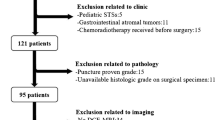Abstract.
This article outlines the ability of MR imaging in staging, grading, tissue characterization, and posttherapeutic surveillance of soft tissue tumors. Well-known staging parameters, such as extent, relationship with adjacent structures, and detection of intralesional necrosis, are used in the MR protocol for locoregional staging. Bone scintigraphy and high-resolution CT scan of the lungs are best methods for ruling out metastatic spread. A variety of (solitary or combinations of) grading parameters are described in the radiological literature. The role of MR imaging is to afford recognition of these lesions that need further aggressive work-up, excluding all others. Despite controversial reports, the definite role of MR imaging in grading of soft tissue tumors seems to become established. As for grading, a lot of individual imaging characteristics used for tissue characterization have low sensitivity, but combinations of parameters (age, site, signal intensities) are more useful and often allow to predict a specific diagnosis or to narrow down the list of differential diagnoses. Local recurrences of soft tissue tumors are frequent and can be detected accurately by an easy-to-use MR algorithm.
Similar content being viewed by others
Author information
Authors and Affiliations
Rights and permissions
About this article
Cite this article
De Schepper, A., De Beuckeleer, L., Vandevenne, J. et al. Magnetic resonance imaging of soft tissue tumors. Eur Radiol 10, 213–223 (2000). https://doi.org/10.1007/s003300050037
Issue Date:
DOI: https://doi.org/10.1007/s003300050037




